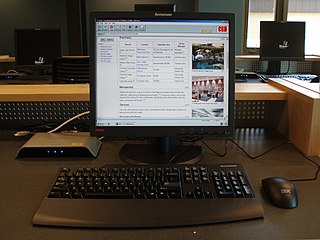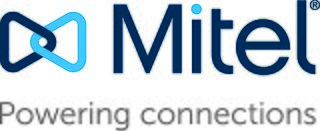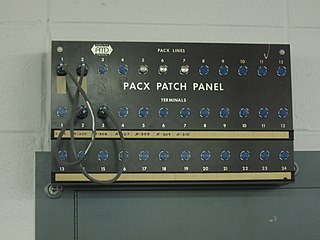In software engineering, multitier architecture or multilayered architecture is a client–server architecture in which presentation, application processing, and data management functions are physically separated. The most widespread use of multitier architecture is the three-tier architecture.
The Session Initiation Protocol (SIP) is a signaling protocol used for initiating, maintaining, and terminating real-time sessions that include voice, video and messaging applications. SIP is used for signaling and controlling multimedia communication sessions in applications of Internet telephony for voice and video calls, in private IP telephone systems, in instant messaging over Internet Protocol (IP) networks as well as mobile phone calling over LTE (VoLTE).

A thin client is a lightweight computer that has been optimized for establishing a remote connection with a server-based computing environment. The server does most of the work, which can include launching software programs, performing calculations, and storing data. This contrasts with a fat client or a conventional personal computer; the former is also intended for working in a client–server model but has significant local processing power, while the latter aims to perform its function mostly locally.
Systems Network Architecture (SNA) is IBM's proprietary networking architecture, created in 1974. It is a complete protocol stack for interconnecting computers and their resources. SNA describes formats and protocols and is, in itself, not a piece of software. The implementation of SNA takes the form of various communications packages, most notably Virtual Telecommunications Access Method (VTAM), the mainframe software package for SNA communications.
GeoPort is a serial data system used on some models of the Apple Macintosh that could be externally clocked to run at a 2 Mbit/s data rate. GeoPort slightly modified the existing Mac serial port pins to allow the computer's internal DSP hardware or software to send data that, when passed to a digital-to-analog converter, emulated various devices such as modems and fax machines. GeoPort could be found on late-model 68K-based machines as well as many pre-USB Power Macintosh models. Some later Macintosh models also included an internal GeoPort via an internal connector on the Communications Slot. Apple GeoPort technology is now obsolete, and modem support is typically offered through USB.
A voicemail system is a computer-based system that allows users and subscribers to exchange personal voice messages; to select and deliver voice information; and to process transactions relating to individuals, organizations, products, and services, using an ordinary telephone. The term is also used more broadly to denote any system of conveying a stored telecommunications voice messages, including using an answering machine. Most cell phone services offer voicemail as a basic feature; many corporate private branch exchanges include versatile internal voice-messaging services, and *98 vertical service code subscription is available to most individual and small business landline subscribers.

Model–View–Controller is a software design pattern commonly used for developing user interfaces which divides the related program logic into three interconnected elements. This is done to separate internal representations of information from the ways information is presented to and accepted from the user. Following the MVC architectural pattern decouples these major components allowing for code reuse and parallel development.

Mitel Networks Corporation is a Canadian telecommunications company. The company previously produced TDM PBX systems and applications, but after a change in ownership in 2001, now focuses almost entirely on Voice-over-IP (VoIP) products. Mitel is headquartered in Ottawa, Ontario, Canada, with offices, partners and resellers worldwide.
Systems Application Architecture (SAA), introduced in 1987, is a set of standards for computer software developed by IBM. The SAA initiative was started in 1987 under the leadership of Earl Wheeler, the "Father of SAA". The intent was to implement SAA in IBM operating systems including MVS, OS/400 and OS/2. AIX, IBM's version of the UNIX operating system, was not a target of SAA, but does have interoperability with the SAA family.

A business telephone system is a multiline telephone system typically used in business environments, encompassing systems ranging in technology from the key telephone system (KTS) to the private branch exchange (PBX).

PACX was a name given by Gandalf Technologies to their family of data switching products.
A service delivery platform (SDP) is a set of components that provides a service(s) delivery architecture for a type of service delivered to consumer, whether it be a customer or other system. Although it is commonly used in the context of telecommunications, it can apply to any system that provides a service. Although the TM Forum (TMF) is working on defining specifications in this area, there is no standard definition of SDP in industry and different players define its components, breadth, and depth in slightly different ways.
Mobile VoIP or simply mVoIP is an extension of mobility to a Voice over IP network. Two types of communication are generally supported: cordless/DECT/PCS protocols for short range or campus communications where all base stations are linked into the same LAN, and wider area communications using 3G/4G protocols.
LinuxMCE is a free and open source software platform with a 10-foot user interface designed to allow a computer to act as a home theater PC (HTPC) for the living-room TV, personal video recorder, and home automation system. It allows control of everything in the home, from lighting and climate to surveillance cameras and home security. It also includes a full-featured VoIP-compatible phone system with support for video conferencing.
Unified communications (UC) is a business and marketing concept describing the integration of enterprise communication services such as instant messaging (chat), presence information, voice, mobility features, audio, web & video conferencing, fixed-mobile convergence (FMC), desktop sharing, data sharing, call control and speech recognition with non-real-time communication services such as unified messaging. UC is not necessarily a single product, but a set of products that provides a consistent unified user interface and user experience across multiple devices and media types.
TalkSwitch was a company that designed and built telephone systems for small and multi-location businesses. The company's Private branch exchange (PBX) and hybrid IP-PBX products enable communication over telephone and Voice over IP (VoIP) networks.
Fixed–mobile convergence (FMC) is a change in telecommunications that removes differences between fixed and mobile networks.
CT Connect is a software product that allows computer applications to monitor and control telephone calls. This monitoring and control is called computer-telephone integration, or CTI. CT Connect implements CTI by providing server software that supports the CTI link protocols used by a range of telephone systems, and client software that provides an application programming interface (API) for telephony functions.
Software-defined networking (SDN) technology is an approach to network management that enables dynamic, programmatically efficient network configuration in order to improve network performance and monitoring making it more like cloud computing than traditional network management. SDN is meant to address the fact that the static architecture of traditional networks is decentralized and complex while current networks require more flexibility and easy troubleshooting. SDN attempts to centralize network intelligence in one network component by disassociating the forwarding process of network packets from the routing process. The control plane consists of one or more controllers which are considered as the brain of SDN network where the whole intelligence is incorporated. However, the intelligence centralization has its own drawbacks when it comes to security, scalability and elasticity and this is the main issue of SDN.

Distributed Data Management Architecture (DDM) is IBM's open, published software architecture for creating, managing and accessing data on a remote computer. DDM was initially designed to support record-oriented files; it was extended to support hierarchical directories, stream-oriented files, queues, and system command processing; it was further extended to be the base of IBM's Distributed Relational Database Architecture (DRDA); and finally, it was extended to support data description and conversion. Defined in the period from 1980 to 1993, DDM specifies necessary components, messages, and protocols, all based on the principles of object-orientation. DDM is not, in itself, a piece of software; the implementation of DDM takes the form of client and server products. As an open architecture, products can implement subsets of DDM architecture and products can extend DDM to meet additional requirements. Taken together, DDM products implement a distributed file system.





